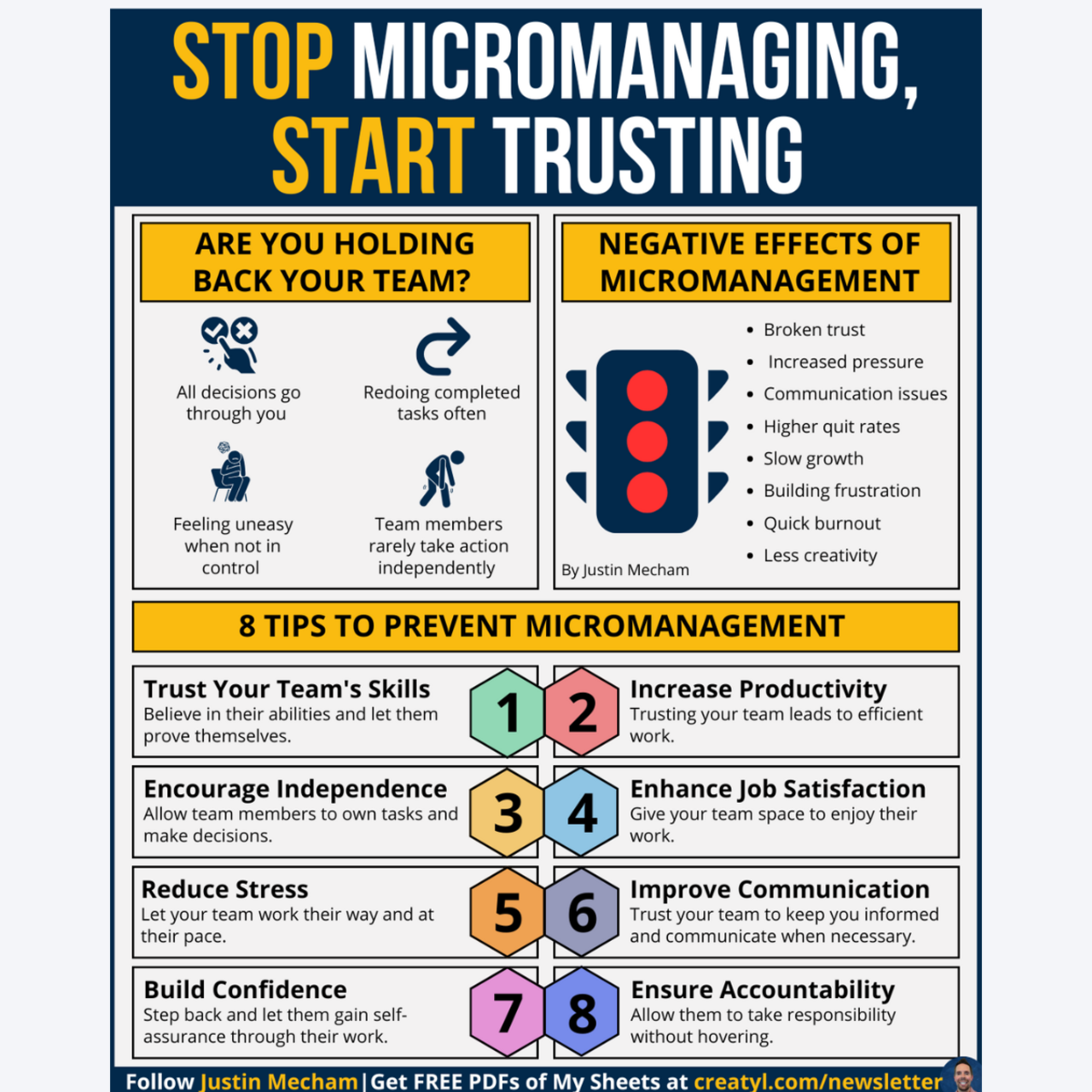Click Here To Download The PDF Version Of Today's Infographic
Micromanagement Isn’t a Strategy—It’s a Symptom
At first glance, micromanagement looks like control. But peel it back and what you often find underneath isn’t leadership. It’s fear.
Fear of failure. Fear of uncertainty. Fear of being left behind.
Leaders rarely micromanage because they want to be difficult. They do it because they feel the pressure to get things right. But here’s the problem: fear-driven leadership doesn’t create success.
It creates silence, resentment, and eventually—failure.
A study from Trinity Solutions showed that 79% of employees have experienced micromanagement at some point in their career. The result? A downward spiral:
- Decisions slow to a crawl
- New ideas stay buried
- Feedback dries up
- Morale drops
- Ownership disappears
- Confidence fades
- Trust breaks—and stays broken
Micromanagement doesn’t prevent mistakes. It guarantees them.
Control Drains Energy. Trust Builds It.
Micromanagement is energy-intensive. It forces leaders to carry the full weight of decisions. It reduces teams to order-takers.
And it replaces creativity with compliance.
Trust, on the other hand, is an energy multiplier.
When people feel trusted, they show up differently.
They don’t just do tasks—they own outcomes. They spot problems before they explode. They speak up when it counts.
And most of all, they stay.
Because when people feel trusted, they don’t leave the first time something goes wrong. They stay and fix it.
When Micromanagement Silenced a Star Performer
A fast-growing fintech startup asked me to observe their product team after a sudden dip in output.
On paper, they had everything: talented people, clear goals, and solid resources.
But deadlines were slipping. Innovation stalled. The team’s most creative product manager—someone who’d previously led two major launches—had gone quiet.
No more ideas. No more feedback. Just yeses and checkboxes.
In private, the manager admitted they stopped speaking up after months of getting picked apart.
Every idea required rewrites. Every update triggered new asks. Their work was constantly re-reviewed by the VP—sometimes rewritten completely without notice.
It wasn’t that they didn’t care. They felt watched. Second-guessed.
So they stopped thinking creatively and just did what they were told. Others followed.
The team got quieter, but not more aligned. Just more tired.
I met with the VP and showed her the team's feedback anonymously.
Her reaction? “I thought I was helping.”
That’s the trap: micromanagement often looks like involvement—but it feels like control.
We rebuilt the process from trust up:
- Every manager owned a full cycle from brief to review
- The VP shifted to weekly vision-setting instead of daily check-ins
- Team leads gave feedback only once per round—then let it land
- We added a new norm: “Disagree in the room, commit outside it”
Three weeks in, that product manager pitched a feature the whole team rallied behind.
It launched 2 months later—and became one of the company’s fastest-adopted updates ever.
All because they finally had room to think again.
Tools That Help Replace Control With Clarity
Book: Multipliers by Liz Wiseman Wiseman explains how the best leaders don’t make themselves the smartest person in the room. They make everyone else smarter. This book is packed with real stories and practical shifts for leaders who want to turn control into trust.
Podcast: The Look & Sound of Leadership by Tom Henschel One of the most respected leadership podcasts, this show explores how perception, communication, and mindset shifts can rebuild trust at work. Especially useful for managers trying to break out of fear-led habits.
Tool: Friday Pulse (Team Happiness Tracker) This tool measures weekly emotional responses from employees. Why it works: it helps managers see beyond deliverables. If stress spikes or trust drops, they know in days—not quarters.
Fear Looks Like Control—But It Feels Like Disconnection
Micromanagement rarely begins as control.
It often begins as care, concern, or the pressure to perform.
But when that care becomes constant checking, decisions slow.
When concern becomes second-guessing, people shrink.
When pressure turns to control, trust quietly exits the room.
You don’t need to change who you are to be a better leader.
You just need to change what you signal.
Trust doesn’t mean letting go of standards.
It means letting go of fear long enough to let others rise.
Because the truth is: when teams feel trusted, they think bigger, speak up, and take more ownership than you ever could have assigned.
What to Try This Week
- Audit your questions.
Are you asking to understand—or to stay in control?
- Name your biggest fear.
Write it out. Say it out loud. Awareness cuts it down to size.
- Give one team member full ownership.
Let them take something end-to-end. Review after they ship it.
- Replace daily check-ins with weekly alignment.
Trust doesn’t mean vanishing—it means respecting space and time.
- Ask for feedback on your leadership—not your ideas.
What’s one thing you do that signals “I don’t trust you”? Then listen.
The best teams aren’t built by hovering over every detail.
They’re built by leaders who know when to step in—and when to step back.
What would your team look like if trust became your operating system?
Want the Infographic Version?
We’ve turned the key points from this blog into a clean, one-page visual PDF—so you can print it, pin it, or share it with your team.
It’s the perfect reminder when fear starts creeping back in.




